接上一篇,本篇主要是面向对象相关的知识点
类
C++可以使用struct和class定义一个类
1
2
3
4
5
6
7
8
9
10
11
12
13
14
15
16
|
struct Person {
int age;
void run {
cout << "person run" << endl;
}
};
class Person {
public:
int age;
void run {
cout << "person run" << endl;
}
}
|
struct和class的区别: class默认权限为private,struct默认权限为public,推荐使用class
嵌套类
C++中类支持嵌套定义,本质是语法糖,用于限制作用域
1
2
3
4
5
6
7
8
9
10
11
12
13
| class Person {
class Car {
}
}
void func() {
class Point {
int x;
int y;
}
}
|
函数调用
1
2
3
| Person p;
p.age = 20;
p.run();
|
转成汇编
1
2
3
4
5
6
7
| mov d word ptr [ebp-0Ch], 0Ah
; 传递调用者到exc,也就是p
lea ecx, [ebp-0Ch]
; 调用函数
call 00061366
|
C++对象的内存结构如下
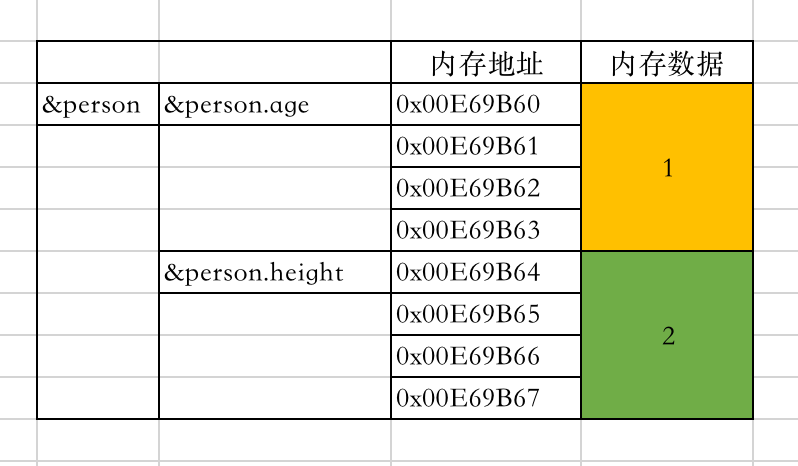
对象的本质,其实就是字段(和虚表指针)的内存集合,先定义的对象会放在低地址,后定义的对象防止高地址
this
this是调用对象的地址,为指针,当对象调用成员函数的时候,会自动传入当前对象的指针
1
2
3
4
5
6
7
8
9
10
11
12
13
14
15
16
17
18
19
20
21
22
23
| class Person {
private:
int m_age;
public:
void func() {
this -> m_age = 0;
}
};
int main() {
Person p = Person();
p.func();
return 0;
}
|
由汇编可以看出,通过寄存器传递this指针,this指针存放对象的地址
堆空间初始化
1
2
3
4
5
6
7
8
9
10
| int *p1 = new int;
int *p2 = new int();
int *p3 = new int(5);
int *p4 = new int[3];
int *p5 = new int[3]();
int *p6 = new int[3]{};
int *p7 = new int[3] {5};
Person *p8 = new Person;
Person *p9 = new Person();
|
对象内存分布
1
2
3
4
5
6
7
8
9
10
11
|
Person g_person;
int main() {
Person person;
Person *p = new Person();
return 0;
}
|
构造函数/析构函数
构造函数支持重载
1
2
3
4
5
6
7
8
9
10
11
12
13
14
15
16
17
18
19
| struct Person {
int m_age;
Person() {
m_age = 10;
}
Person(int age) {
m_age = age;
}
~Person() {
}
};
Person person(20);
cout << person.age << endl;
|
如果自定义了构造函数,除了全局区(默认会初始化为0),其他内存空间的成员变量都需要手动初始化
1
2
3
4
5
6
7
8
9
| struct Person {
int age;
Person() {
msmset(this, 0, sizeof(Person));
}
};
|
构造函数和析构函数必须是public,如果定义为private,则该类无法被外部创建
构造函数先调用父类,后调用子类
析构函数先调用子类,后调用父类
成员访问权限
权限与JAVA一样,对类的成员变量声明权限(struct默认为public,class默认为private)
public:公开访问(struct默认)protected:当前类和子类访问private:私有(class默认)
继承关系也可以添加权限,表示继承的成员对子类的权限,struct默认为public,class默认为private,class要手写public
1
2
3
4
|
struct Student: private Person {
int m_score;
};
|
初始化列表
1
2
3
4
5
6
7
8
9
10
11
12
13
14
15
| struct Person {
int m_age;
int m_height;
Person(int age, int height): m_age(age), m_height(height) {
}
};
|
初始化顺序跟成员变量的声明顺序有关系,和列表顺序无关,下面写法是一样的
1
2
3
4
| Person(int age, int height): m_age(age), m_height(height) { }
Person(int age, int height): m_height(height), m_age(age) { }
|
构造函数互相调用
1
2
3
4
5
6
7
8
9
10
11
12
13
14
15
| struct Person {
int m_age;
int m_height;
Person() : Person(0, 0) {
}
Person(int age, int height) {
m_age = age;
m_height = height;
}
};
|
父类的构造函数
1
2
3
4
5
6
7
8
9
10
11
12
13
14
15
16
17
18
19
20
21
| struct Person {
private:
int m_age;
Person() {
m_age = 0;
}
Person(int age): m_age(age) {
}
};
struct Student : Person {
Student() : Person(10) {
}
};
|
- 如果父类没有构造函数,则不调用
- 如果父类有构造函数,子类没有定义构造函数,则子类会隐式生成构造函数,并且调用父类的构造函数
调用父类方法
继承关系中调用父类方法,通过类名调用
1
2
3
4
5
6
7
8
9
10
11
12
13
14
15
16
17
18
19
| class Person {
public:
void func() { }
}
class Student: public Person {
public:
void func() {
Person::func();
}
Student &operator=(const Student &student) {
Person::operator=(student);
...
}
}
|
拷贝构造函数
1
2
3
4
5
6
7
8
9
10
11
12
13
14
15
16
17
18
19
20
21
22
23
24
| class Person {
public:
int m_age;
Person() {}
Person(const Person &person): m_age(person.m_age) { }
};
int main() {
Person p1 = Person();
Person p2;
Person p3 = p1;
Person p4(p1);
p2 = p1;
return 0;
}
|
隐式构造
1
2
3
4
5
6
7
8
9
10
11
| class Person {
private:
int m_age;
public:
Person(int age): m_age(age) { }
};
Person p1(10);
Person p2 = 20;
|
可读性差,尽量不用,可以通过关键字explicit禁用隐式构造
1
2
|
explicit Person(int age): m_age(age) { }
|
自动生成构造函数
在下面情况下,编译器会自动为类生成无参构造函数
- 父类存在构造函数,子类没有定义构造函数
- 虚继承(需要做虚表指针的初始化)
- 有虚函数(需要做虚表指针的初始化)
- 类包含了有构造函数的成员,并且没有定义构造函数,则编译器会自动生成构造函数初始化成员
- 类的字段在声明的时候进行了初始化
仿函数
相当于直接调用对象,本质是重载()运算符
1
2
3
4
5
6
7
8
9
10
| class Sum {
public:
int operator()(int a, int b) {
return a + b;
}
}
auto sum = Sum();
auto res = sum(10, 20);
|
深拷贝/浅拷贝
多态
C++的多态通过虚函数来实现
虚函数
需要在父类方法实现virtual函数才能使用多态,否则不是多态(不加virtual,编译器直接根据类型调用对应的函数)
1
2
3
4
5
6
7
8
9
10
11
12
13
14
15
16
17
18
19
20
21
22
23
24
25
26
27
| struct Animal {
void speak() {
cout << "animal speak" << endl;
}
};
struct Dog: Animal {
void speak() {
cout << "dog speak" << endl;
}
};
void func(Animal *ani) {
ani.speak();
}
int main() {
Dog *dog = new Dog();
func(dog);
delete dog;
return 0;
}
|
修改Animal::speak改为virtual
1
2
3
4
5
6
7
| struct Animal {
virtual void speak() {
cout << "animal speak" << endl;
}
};
|
- 纯虚函数:没有实现的虚函数,后面用等于0
- 抽象类:含有纯虚函数的类,抽象类不能被实例化
1
2
3
4
5
| struct Animal {
virtual void speak() = 0;
virtual void run() = 0;
}
|
虚表
虚函数的多态特性是通过虚表来实现的,如果一个类对象有虚函数,则会多4或8个字节,32或64位环境不同,并且多出来的内存是放在对象首地址
1
2
3
4
5
6
7
8
9
10
11
12
13
| struct Animal {
int m_age;
virtual void speak() {
cout << "animal speak" << endl;
}
virtual void run() {
cout << "animal run" << endl;
}
};
cout << sizeof(Animal) << endl;
|
原理:多出的4/8个字节用来存储虚函数表的地址,虚函数表存放着对象的虚函数地址,编译器在运行时通过该表,找到对应的函数地址执行,从而达到多态的目的
1
2
3
4
5
6
7
8
9
10
11
12
13
14
| Animal *ani = new Dog();
ani.speak();
ani.run();
|
从汇编代码可以看出,虚函数的调用过程
- 通过对象存放的
虚表地址(对象首地址)
- 通过虚表地址找到虚表,从虚表中找到对应函数的地址
- 调用函数
同个类所有对象共用一份虚表,不管对象使用什么指针接收,最终都会调用虚表的方法,也就是对象真正的方法
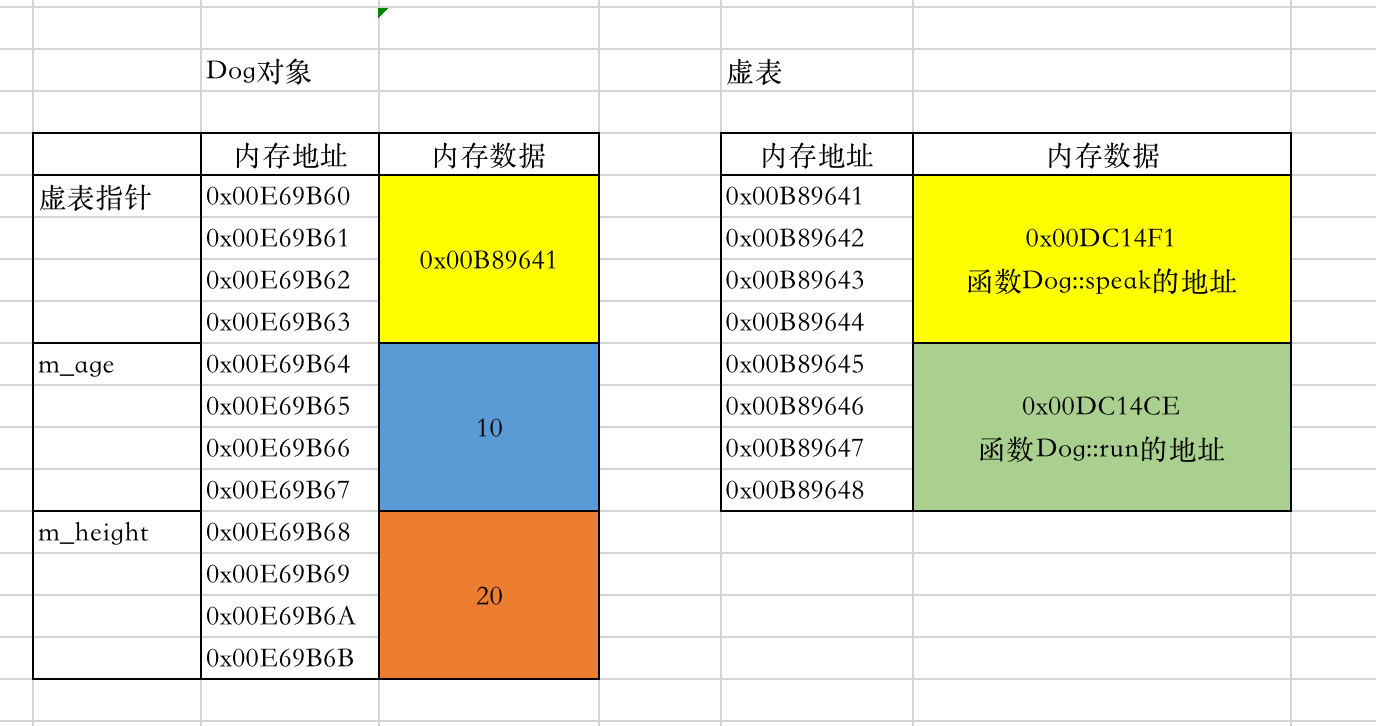
注意:如果子类没有重写父类的虚函数,父类的虚函数编译的时候也会被放到子类的虚表里面,也就是函数调用在编译的时候就确定了,如下
1
2
3
4
5
6
7
8
9
10
11
12
13
14
15
16
| struct Animal {
virtual void speak() { }
virtual void run() { }
}
struct Dog : Animal {
void run() { }
}
struct WhiteDog: Dog {
}
WhiteDog *dog = new WhiteDog();
|
多态的调用行为在编译后就确定了,而不是运行时动态确定
多态-析构函数
由于C++多态使用的虚表实现的,对于多态,析构函数也要使用虚函数
1
2
3
4
5
6
7
8
9
10
11
12
13
14
15
16
17
18
19
| using namespace std;
struct Animal {
~Animal {
cout << "Animal::~Animal" << endl;
}
}
struct Dog: Animal {
~Dog {
cout << "Dog::~Dog" << endl;
}
}
Animal *ani = new Dog();
delete ani;
|
需要把Animal的析构函数设置为virtual
1
2
3
4
5
6
| struct Animal {
virtual ~Animal {
cout << "Animal::~Animal" << endl;
}
}
|
多态继承
如果要用父类指针指向子类对象,则继承的权限必须是public
1
2
3
4
5
6
7
8
9
| class Person { }
class Student: public Person {
}
Person *person = new Student()
|
调用父类方法
直接通过类名调用
1
2
3
4
5
6
7
8
9
10
11
12
13
14
15
16
17
18
19
20
21
| using namespace std;
struct Animal {
virtual void speak() {
cout << "animal speak" << endl;
}
void run() { }
}
struct Dog: Animal {
void speak() {
Animal::speak();
Animal::run();
cout << "animal speak" << endl;
}
}
|
多继承
C++支持多继承(不建议使用,会增加程序设计的复杂度)
1
2
3
4
5
6
7
8
9
10
11
12
13
14
15
16
17
18
19
20
21
22
23
24
25
26
27
28
29
| class Student {
public:
int m_score;
void study() { }
};
class Worker {
public:
int m_salary;
void work() { }
};
class Undergraduate: public Student, public Worker {
public:
int m_grade;
void play() { }
};
int main() {
Undergraduate ug;
ug.m_score = 10;
ug.m_salary = 20;
ug.m_grade = 30;
ug.study();
ug.work();
ug.play();
return 0;
}
|
内存分布
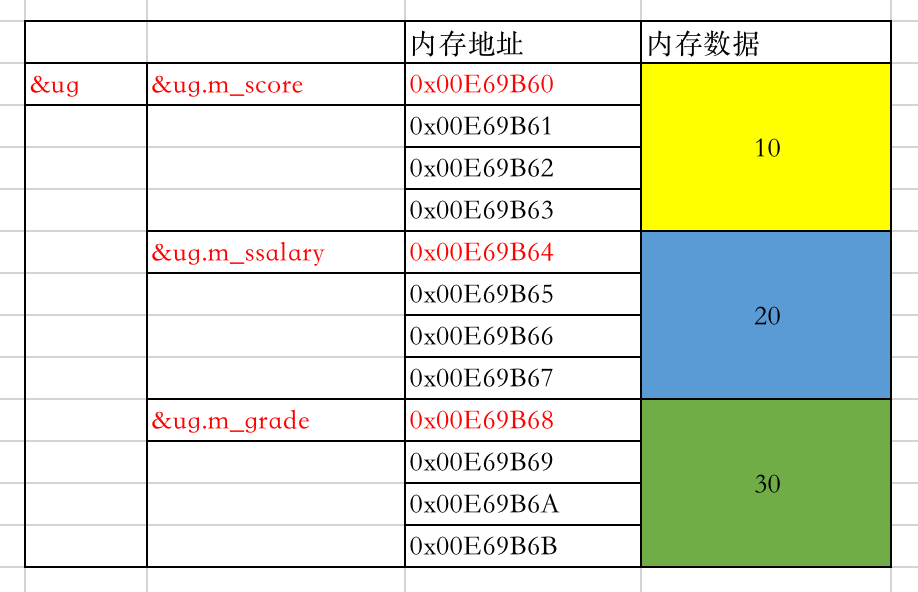
多继承-虚函数
多继承的多态也是通过虚函数实现的,单继承一样,但是由于又多个父类,多继承会又多个虚表地址
多继承的子类会产生多张虚表,分别对应不同父类
1
2
3
4
5
6
7
8
9
10
11
12
13
14
15
16
17
18
19
20
21
22
23
24
25
26
27
28
29
30
31
| class Student {
public:
int m_score = 1;
virtual void func() {
cout << "student func" << endl;
}
};
class Worker {
public:
int m_salary = 2;
virtual void func() {
cout << "worker func" << endl;
}
};
class Undergraduate : public virtual Student, public virtual Worker {
public:
int m_grade = 3;
void func() {
cout << "undergraduate func" << endl;
}
};
int main() {
Undergraduate *undergraduate = new Undergraduate();
Student *stu = undergraduate;
cout << stu->m_score; << endl;
stu->func();
return 0;
}
|
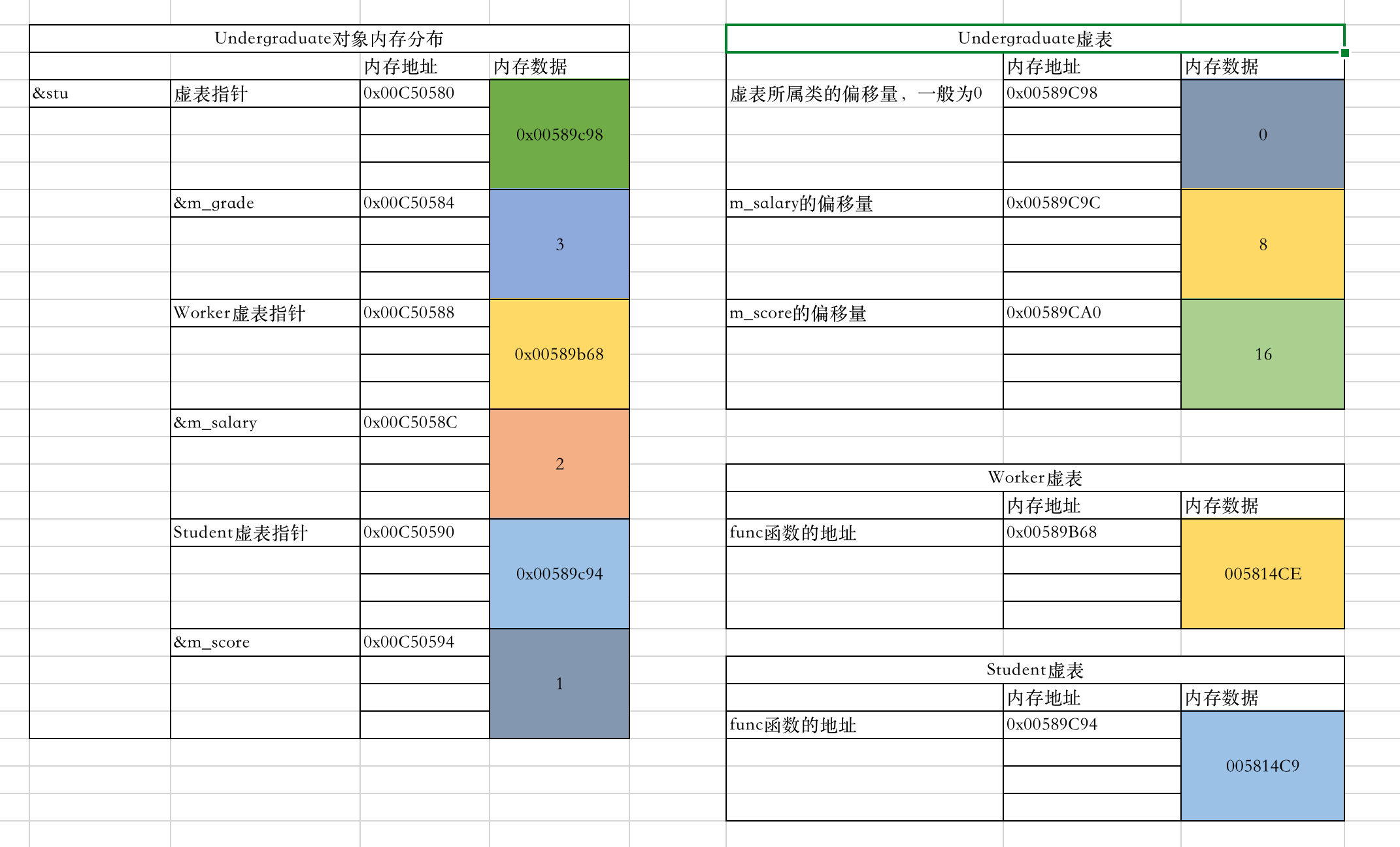
同名函数/变量问题
对于同名变量,C++默认会当成多个变量来存储
1
2
3
4
5
6
7
8
9
10
11
12
13
14
15
16
17
18
19
20
21
22
23
24
25
| class Student {
public:
int m_age = 1;
}
class Worker {
public:
int m_age = 2;
}
class Undergraduate {
public:
int m_age = 3;
}
int main() {
Undergraduate *under = new Undergraduate();
cout << under->m_age << endl;
Student* stu = under;
cout << stu->m_age << endl;
return 0;
}
|
内存分布
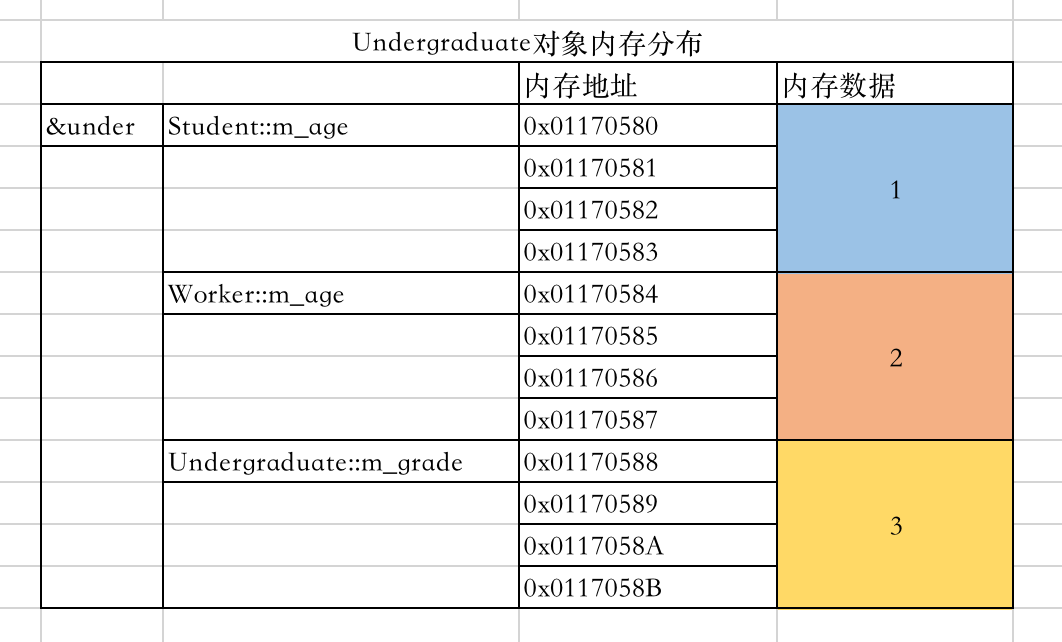
菱形继承
由于C++支持多继承,所以会出现菱形继承这种情况,我们知道子类会继承父类的所有成员变量(包括同名的)
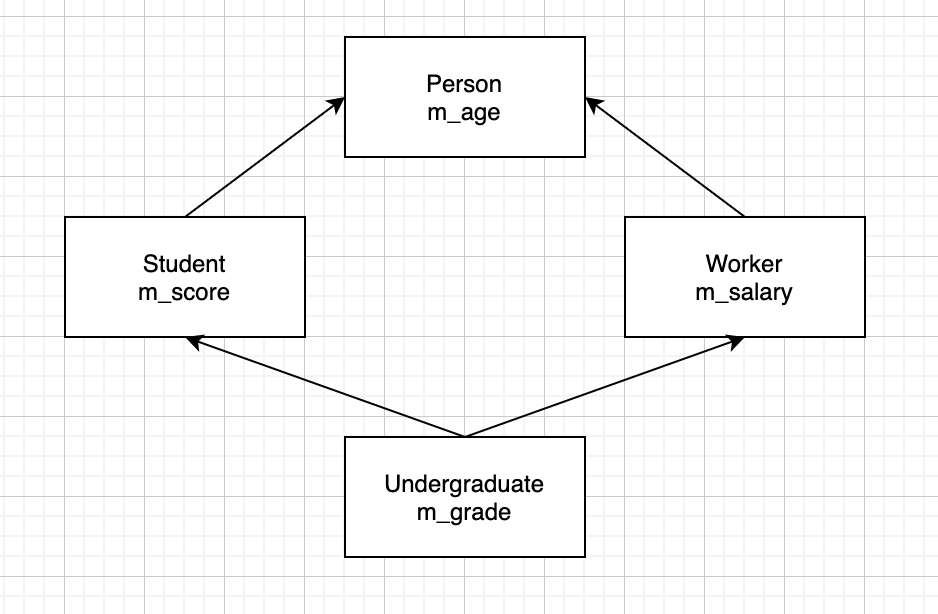
1
2
3
4
5
6
7
8
9
10
11
12
13
14
15
16
17
18
19
20
21
22
23
24
25
26
27
28
29
30
31
32
| class Person {
public:
int m_age = 1;
};
class Student: public Person {
public:
int m_score = 2;
};
class Worker: public Person {
public:
int m_salary = 3;
};
class Undergraduate : public Student, public Worker {
public:
int m_grade = 4;
};
int main() {
Undergraduate *under = new Undergraduate();
under->m_age = 10;
under->Student::m_age = 11;
under->Worker::m_age = 11;
return 0;
}
|
Undergraduate的内存分布
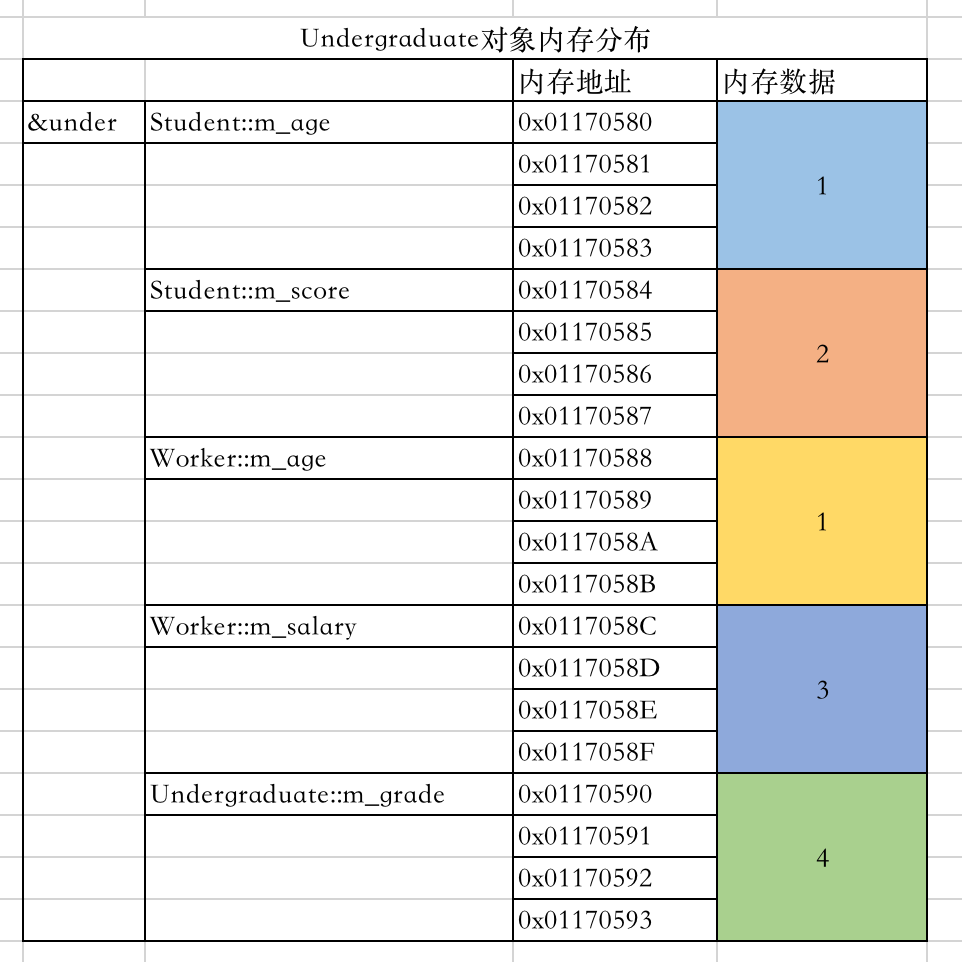
虚继承
上面Undergraduate会继承两份Person的成员m_age,为了避免这种情况(通常我们希望只继承一份成员变量),C++使用虚继承解决
1
2
3
4
5
6
7
8
9
10
11
12
13
14
15
16
17
18
19
20
21
22
23
24
25
26
27
28
29
| class Person {
public:
int m_age = 1;
};
class Student: virtual public Person {
public:
int m_score = 2;
};
class Worker: virtual public Person {
public:
int m_salary = 3;
};
class Undergraduate : public Student, public Worker {
public:
int m_grade = 4;
};
int main() {
Undergraduate *under = new Undergraduate();
under->m_age = 10;
cout << sizeof(Undergraduate) << endl;
return 0;
}
|
内存分布
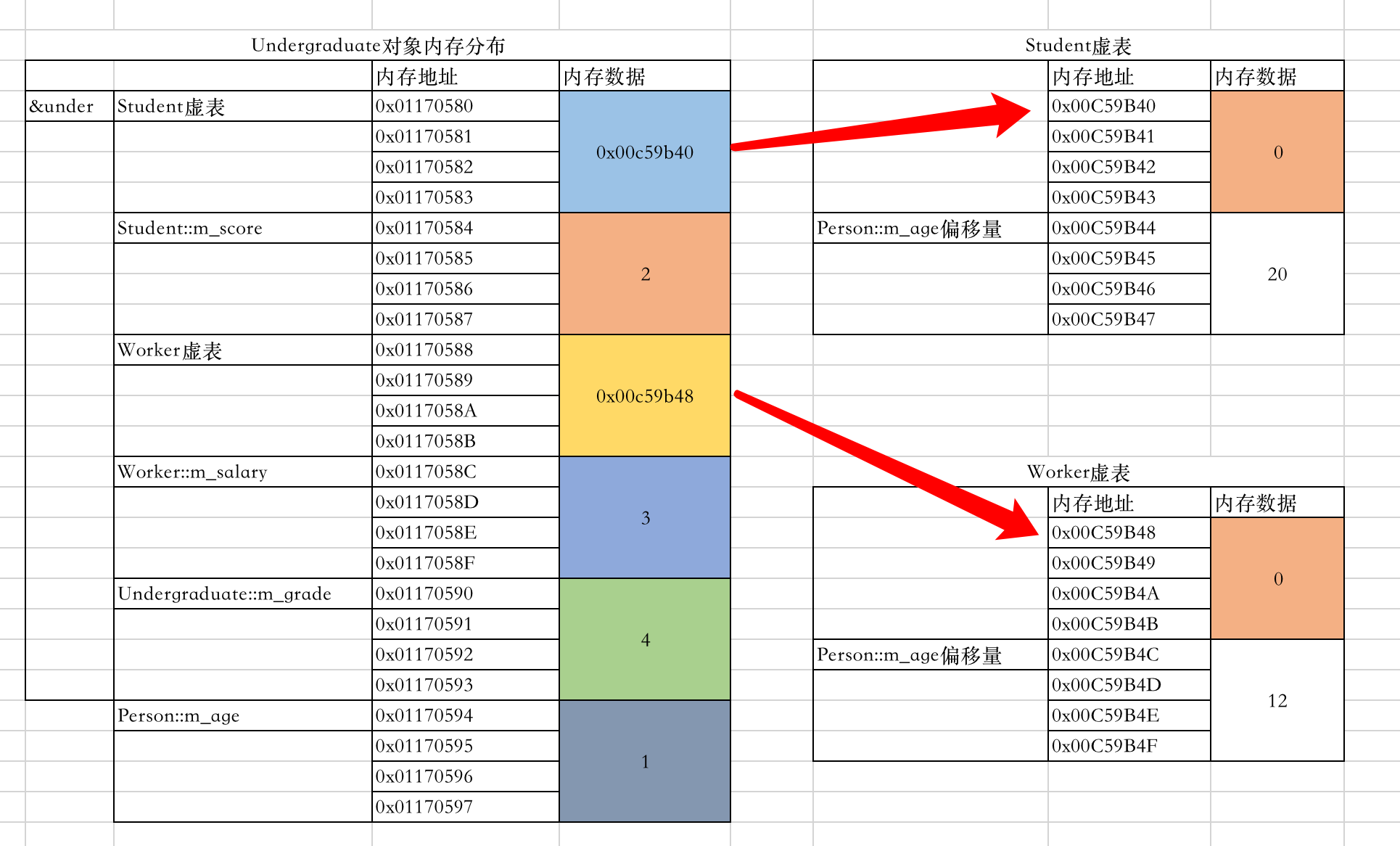
可以看到出多了两个虚表,用于声明基类字段m_age的偏移量,m_age只有一份
静态成员
友元
友元方法:可以在类外部的方法访问类的所有成员(字段和方法)
友元类:可以在其他类访问类的所有成员(字段和方法)
1
2
3
4
5
6
7
8
9
10
11
12
13
14
15
16
17
18
19
20
21
22
23
24
25
26
27
28
29
30
31
32
| class Point {
friend Point add(const Point &a, const Point &b);
friend class Math;
private:
int m_x;
int m_y;
void func() { }
public:
Point(int x, int y): m_x(x), m_y(y) {
}
};
Point add(const Point &a, const Point &b) {
return Point(a.m_x + b.m_x, a.m_y + b.m_y);
}
class Math {
void func() {
Point p = Point(1, 2);
p.m_x = 10;
p.m_y = 20;
p.func();
}
};
|
下一篇主要是C++的新特性







